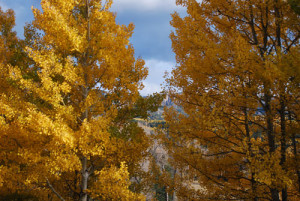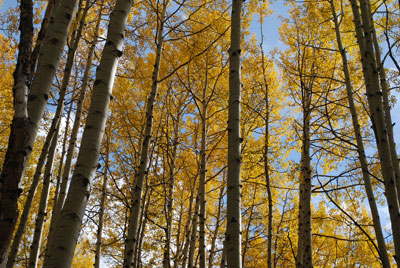Observing Colorado Aspen – the largest living thing on Earth!

by Norm Vance
 Several seasons ago popular radio personality Paul Harvey reported a news story about two Michigan biologists who presented an academic research paper reporting on their finding “the largest living thing on earth.” The “thing” was a 40-acre fungus. This sent scientists around the world scrambling to find their own “largest living thing.” Soon, another report was passed on by Harvey from another scientist who reported finding a fungus covering 1500 acres in Washington State.
Several seasons ago popular radio personality Paul Harvey reported a news story about two Michigan biologists who presented an academic research paper reporting on their finding “the largest living thing on earth.” The “thing” was a 40-acre fungus. This sent scientists around the world scrambling to find their own “largest living thing.” Soon, another report was passed on by Harvey from another scientist who reported finding a fungus covering 1500 acres in Washington State.
These massive fungi exist mostly underground. Some fungi have protrusion that poke up through the earth’s surface. The protrusions are called mushrooms.
The distinctive factor in searching for and naming the largest living thing is that when a DNA test is done on any part of it the results are identical to all other parts. It is genetically the same being or each part of it is a “clone” of the main being. When they test and stop getting the same results they know they have gone beyond the “things” edge.
Now we have a new entry in the largest thing race. Michael C. Grant, University of Colorado scientist, published a paper to “set the record straight.” Grant discounted the fungi and claimed the aspen is the largest living thing.
If asked most people think of whales or giant redwood trees as the largest living things. The Washington fungus, at a calculated 825,000 pounds, was about twice the weight of a blue whale but no where near the weight of a giant sequoia red wood tree. A lot of this argument is based on the perspective one has on “largest.”
 Grant pointed out that aspen trees commonly grow by the “vegetative method”. This means that a tree grows roots near the surface of the ground from which new trees sprout. The new trees are genetically identical to the parent tree. This process of reproduction can grow vast forests of aspen that are all interconnected by roots and are one genetic individual. Common “crab grass” grows and spreads the same way and this is the reason it is so hard to free a yard of it.
Grant pointed out that aspen trees commonly grow by the “vegetative method”. This means that a tree grows roots near the surface of the ground from which new trees sprout. The new trees are genetically identical to the parent tree. This process of reproduction can grow vast forests of aspen that are all interconnected by roots and are one genetic individual. Common “crab grass” grows and spreads the same way and this is the reason it is so hard to free a yard of it.
Grant studied an aspen clone in Utah consisting of a calculated 47,000 tree trunks covering 106 acres. It is calculated to weigh 13 million pounds. This dwarfed the previous claims. He named the stand Pando for the Latin word meaning “to spread”.
Anyone passing through the San Juan Forest can enjoy observing aspen based Dr. Grant’s information. Hikers, bikers or horseback riders who go slow and stop often can observe best. As you pass along watch for changes in the aspen. One clone will likely be different than a neighboring clone. Watch for branch angle from the trunk which can vary from about 45 degrees to 80 degrees in different clones. Some clones tend to have branches closer to the ground while others have branches very high up on the truck. As you move and watch you should be able to tell when you pass from one clone to another. You may also observe that you are in an area where two or more clones have overlapped and grow in the same space. It is common to move from a clone into a mixed area and then into a new clone.
You may find an odd-ball tree growing in an otherwise homogenous stand. It is likely that this tree is growing from a leaf or twig a bird or the wind carried from afar. It fell to the earth, rooted and grew into this tree and one day it may spread and become a new clone in the area.
Also, a good time to observe aspen clones is during spring and fall. In spring all trees in a clone tend to bud and leaf-out at about the same time. In the fall all leaves in a clone tend to turn their fall colors at about the same time and they tend to turn the same shades of yellow, orange or red. The vivid fall colors make it easy to identify clones from a distance.
People planting aspen trees often find the tree they planted dies after a season or two but, if they wait, new sprouts come up a few feet to the side and grow into healthy trees. This is the spreading process at work.
We hope this new information on aspen will make your time in the forest more interesting. Remember that Grant has not looked at all aspen stands. It is entirely possible that a clone will be found larger than Pando and it may well be in the, San Juan Forest as huge stands of aspen grow here.


I planted a Colorado Aspen in my yard a few years ago [10 years].
It is a beautiful tree but this winter I plan on cutting it down. It has destroyed my yard with all the small tree sprouts that have come up. I have found it easy to cut the new sprouts off with the lawn mower, but a “scab” remains and and makes the lawn look horrible. It has reached the point that I worry about my basement wall–cement block–collapsing if the roots continue to spread.
The procedure that I am planning to use to get rid of the tree is to cut it down this winter and for the next few years watch closely for any new sprouts and pull the roots that are feeding them. Is there an easier method of getting rid of this tree”
Thanks
Jim